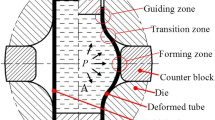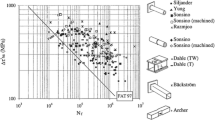Abstract
Developments in the numerical simulation of the hydroforming process of tubular metallic components, tailor-welded before forming, are presented. Both technologies, tailor-welded joining operations and hydroforming processes, are well known in industry, although most commonly separately used. Tailor-welded joining operations are usually encountered in plain sheets, subsequently formed by stamping. Tube hydroforming processing, on the other hand, is frequently associated with parts consisting of uniform thickness, material properties, and dimensions. The present analysis focuses on the influence of process parameters, such as the position of the weld-line and initial thickness values, in the innovative process of combining tailor-welded tubes (with distinct thickness values) and hydroforming. Particular attention is posed on the relation of imposed axial displacement vs. imposed hydraulic pressure into the tube, forming parameters that are not known a-priori in the manufacturing of a new part. Another point of practical interest is the numerical simulation of the weld-line movement, after forming is complete. The finite element method is directly employed in the numerical simulation by means of innovative solid elements suited for incompressibility applications, and included by the authors into the commercial program ABAQUS as user-elements. The obtained results can then lead to a better understanding, along with design tools, for the process of hydroforming of tailor-welded tubular parts, accounting for dissimilar thickness of the basic components.
Similar content being viewed by others
References
Ahmetoglu M, Sutter K, Li XJ, Altan T (2000) Tube hydroforming: current research, applications and need for training. J Mat Proc Tech 98:224–231
Gélin JC, Laberge C (2004) Application of optimal design and control strategies to the forming of thin walled metallic tubes. Int J Forming Proc 98:141–158
Jirathearanat S, Altan T (2004) Optimization of loading paths for tube hydroforming. Proc 8th Int Conf Numer Methods Industrial Forming Processes (NUMIFORM’2004). Ohio, USA
Dohmann F, Hartl C (1996) Hydroforming: a method to manufacture light-weighted parts. J Mat Proc Tech 60:669–676
Koç M, Aue-U-Lan Y, Altan T (2001) On the characterization of tubular materials for hydroforming: experimentation and analysis. Int J Machine Tool Manuf 41:761–772
Kim S, Kim Y (2002) Analytical study for tube hydroforming. J Mat Proc Tech 128:232–239
Yang B, Zhang WG, Li SH (2006) Analysis and finite element simulation of the tube bulge hydroforming process. Int J Adv Manuf Technol 29:453–458
Kim J, Kim SW, Park HJ, Kang BS (2006) A prediction of bursting failure in tube hydroforming process based on plastic instability. Int J Adv Manuf Technol 27:518–524
Roque AP, Natal Jorge RM, Parente MPL, Fontes Valente RA, Fernandes AA (2005) Hydroforming of tailor-welded tubular blanks. Proc 8th ESAFORM Conf Material Forming. Cluj-Napoca, Romania
Roque AP, Natal Jorge RM, Parente MPL, Fontes Valente RA, Fernandes AA (2005) Hydroforming of tailor-welded tubular blanks (2005) Proc Int Conf Numerical Methods in Engng. Granada, Spain
Roque AP, Natal Jorge RM, Parente MPL, Fontes Valente RA, Fernandes AA (2005) The influence of the heat affected zone on the hydroforming of tailor-welded tubular blanks (2005) Proc 8th Int Conf Comput Plasticity, Fundamentals and Applications (COMPLAS’2005). Barcelona, Spain
Tailor-Welded Blank Project Team (2001) Tailor-welded blank application and manufacturing: a state-of-the-art survey. The Auto/Steel Partnership http://www.a-sp.org/database/publicationmain.asp)
Zhao KM, Chun BK, Lee JK (2001) Finite element analysis of tailor-welded blanks. Finite El. Anal Design 37:117–130
Tang BT, Zhao Z, Wang Y (2007) One-step FEM-based evaluation of weld line movement and development of blank in sheet metal stamping with tailor-welded blanks. Int J Adv Manuf Technol (in press) (DOI 10.1007/s00170-006-0715-z)
Zhang J (2007) Optimization of contact forces in tailor-welded blanks forming process. Int J Adv Manuf Technol (in press) (DOI 10.1007/s00170-006-0491-9)
ABAQUS (2002) Version 6.3. Hibbitt, Karlsson & Sorensen Inc., Rhode-Island, USA
Harnau M, Schweizerhof K (2002) About linear and quadratic solid-shell elements at large deformations. Comp Structures 80:805–817
Klinkel S, Govindjee S (2002) Using finite strain 3D-material models in beam and shell elements. Eng Computat 19:902–921
Cardoso RPR, Yoon JW (2005) One-point quadrature shell elements for sheet metal forming analysis. Arch Comput Mech Engng 12:3–66
Bathe KJ (1996) Finite element procedures, 2nd edn. Prentice-Hall, New Jersey
Belytschko T, Liu WK, Moran B (2000) Nonlinear finite elements for continua and structures. Wiley, West Sussex, UK
Simo JC, Rifai MS (1990) A class of mixed assumed strain methods and the method of incompatible modes. Int J Numer Methods Eng 29:1595–1638
Simo JC, Armero F (1992) Geometrically non-linear enhanced strain mixed methods and the method of incompatible modes. Int. J Numer Methods Eng 3:1413–1449
Simo JC, Armero F, Taylor RL (1993) Improved versions of assumed enhanced strain tri-linear elements for 3D finite deformation problems. Comput Methods Appl Mech Eng 110:359–386
Alves de Sousa RJ, Natal Jorge RM, Fontes Valente RA, César de Sá JMA (2003) A new volumetric and shear locking-free 3D enhanced strain element. Eng Computat 20:896–925
Fontes Valente RA, Alves de Sousa RJ, Natal Jorge RM (2004) An enhanced strain 3D element for large deformation elastoplastic thin-shell applications. Comput Mech 34:38–52
Fontes Valente RA, Parente MPL, Natal Jorge RM, César de Sá JMA, Grácio JJ (2005) Enhanced transverse shear strain shell formulation applied to large elasto-plastic deformation problems. Int J Numer Methods Eng 62:1360–1398
Parente MPL, Fontes Valente RA, Natal Jorge RM, Cardoso RPR, Alves de Sousa RJ (2006) Sheet metal forming simulation using EAS solid-shell finite elements. Finite Elem Anal Des 42:1137–1149
Alves de Sousa RJ, Cardoso RPR, Valente RAF, Yoon JW, Grácio JJ, Natal Jorge RM (2005) A new one-point quadrature enhanced assumed strain (EAS) solid-shell element with multiple integration points along thickness. Part I: Geometrically linear applications. Int J Numer Methods Eng 62:952–977
Alves de Sousa RJ, Cardoso RPR, Valente RAF, Yoon JW, Grácio JJ, Natal Jorge RM (2006) A new one-point quadrature enhanced assumed strain (EAS) solid-shell element with multiple integration points along thickness. Part II: Nonlinear applications. Int J Numer Methods Eng 67:160–188
Natal Jorge RM, Roque AP, Parente MPL, Fontes Valente RA, Fernandes AA (2004) Simulation of tubular hydroforming. Proc 4th Int Conf Engineering and Computational Technology. Lisbon, Portugal
Reis AR, Teixeira P, Ferreira Duarte J, Santos A, Barata da Rocha A, Fernandes AA (2004) Tailored welded blanks–an experimental and numerical study in sheet metal forming on the effect of welding. Comp Struct 82:1435–1442
Author information
Authors and Affiliations
Corresponding author
Additional information
Funding by Ministerio da Ciência, Inovação e Ensino Superior (FCT -Portugal) and FEDER/FSE, under grants POSI SFRH/BD/13013/2003, PTDC/EME-TME/66435/2006 and POCTI/EME/47289/2002, are gratefully acknowledged.
Rights and permissions
About this article
Cite this article
Valente, R.A.F., Jorge, R.M.N., Roque, A.P. et al. Simulation of dissimilar tailor-welded tubular hydroforming processes using EAS-based solid finite elements. Int J Adv Manuf Technol 37, 670–689 (2008). https://doi.org/10.1007/s00170-007-1015-y
Received:
Accepted:
Published:
Issue Date:
DOI: https://doi.org/10.1007/s00170-007-1015-y




